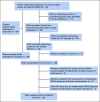NOHA: A Promising Biomarker for Determining Estrogen Receptor Status Among Patients With Breast Cancer in Resource-Constrained Settings
- PMID: 36542825
- PMCID: PMC10166386
- DOI: 10.1200/GO.22.00192
NOHA: A Promising Biomarker for Determining Estrogen Receptor Status Among Patients With Breast Cancer in Resource-Constrained Settings
Abstract
Purpose: Challenges to breast cancer control in low-and middle-income countries exist because of constrained access to care, including pathology services. Immunohistochemistry (IHC)-based estrogen receptor (ER) analysis is limited-nonexistent because of few and inadequately staffed and equipped pathology laboratories. We have identified Nw-hydroxy-L-Arginine (NOHA) as a blood-based biomarker to distinguish ER status in US patients with breast cancer. Here, we examine NOHA's clinical utility as an ER IHC alternative in Tanzanian patients.
Materials and methods: Following informed consent, 70 newly diagnosed, known or suspected patients with breast cancer were enrolled at Kilimanjaro Christian Medical Center; basic, deidentified clinical and sociodemographic data were collected. For each, a needle prick amount of blood was collected on a Noviplex plasma card and stored at -80°C. Plasma cards and unstained tumor pathology slides were shipped regularly to US laboratories for NOHA, histologic and IHC analysis. NOHA and IHC assay operators were blinded to each other's result and patient clinical status. Paired NOHA and IHC results were compared.
Results: Slides from 43 participants were available for pathological analysis in the United States. Of those with confirmed malignancy (n = 39), 44%, 51%, 5% were ER-positive, ER-negative, and ER inconclusive, respectively. NOHA levels were available among 33 of 43 of those with pathological data and showed distinct threshold levels correlating 100% to tumor ER IHC and disease categorization where a level below 4 nM, from 4 to 8 nM, and above 8 nM signified ER-negative, ER-positive, and no cancer, respectively.
Conclusion: The results are consistent with findings from US patients and suggest NOHA's clinical utility as an accessible IHC replacement in determining ER status among low-and middle-income country patients with breast cancer, promising to extend access to cost-efficient, available hormonal agents and improve outcomes.
Conflict of interest statement
The following represents disclosure information provided by authors of this manuscript. All relationships are considered compensated unless otherwise noted. Relationships are self-held unless noted. I = Immediate Family Member, Inst = My Institution. Relationships may not relate to the subject matter of this manuscript. For more information about ASCO's conflict of interest policy, please refer to
Open Payments is a public database containing information reported by companies about payments made to US-licensed physicians (
No other potential conflicts of interest were reported.
Figures


References
-
- DeSantis CE, Bray F, Ferlay J, et al. : International variation in female breast cancer incidence and mortality rates. Cancer Epidemiol Biomarkers Prev 24:1495-1506, 2015 - PubMed
-
- Sung H, Ferlay J, Siegel RL, et al. : Global cancer statistics 2020: GLOBOCAN estimates of incidence and mortality worldwide for 36 cancers in 185 countries. CA: Cancer J Clin 71:209-249, 2021 - PubMed
-
- Cancer IAfRo: Cancer Today ‐ Breast Cancer Fact Sheets. https://gco.iarc.fr/today/data/factsheets/cancers/20-Breast-fact-sheet.pdf, 2020
-
- World Health Organization : World Health Organization Model List of Essential Medicines, 2019. https://apps.who.int/iris/bitstream/handle/10665/325771/WHO-MVP-EMP-IAU-...
Publication types
MeSH terms
Substances
LinkOut - more resources
Full Text Sources
Medical

